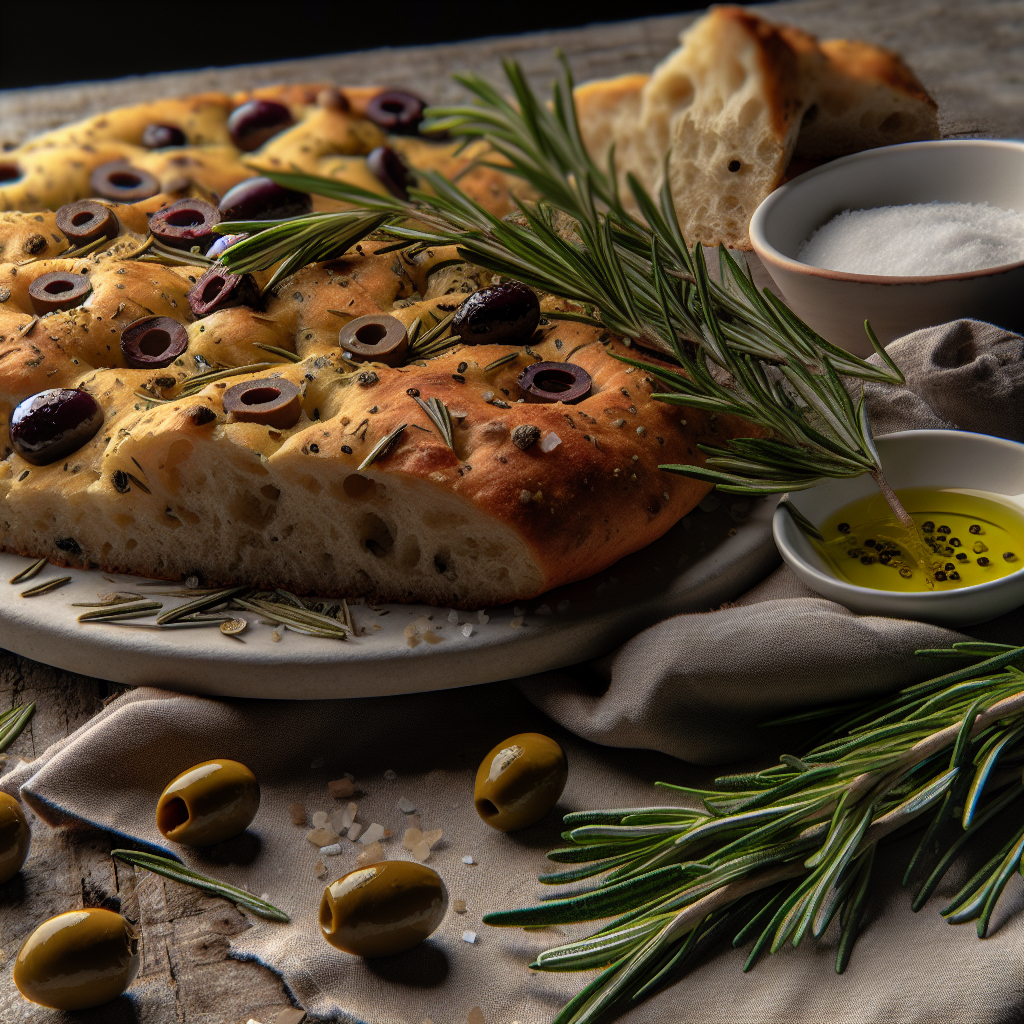
Transport yourself to the Italian countryside with this aromatic rosemary and olive focaccia bread. This rustic, artisanal bread features a perfectly crispy crust, pillowy interior, and is studded with fragrant rosemary and rich Kalamata olives. It's easier to make than you think!
Ingredients for Homemade Rosemary Olive Focaccia: A Rustic Italian Bread Recipe
- 0.25oz Active Dry Yeast
- 12oz Warm Water
- 16oz All-Purpose Flour
- 2 tsp Salt
- 4 tbsp Extra Virgin Olive Oil
- 4 sprigs Fresh Rosemary
- 3.5oz Kalamata Olives, pitted and halved
- 1 tsp Coarse Sea Salt
Instructions for Homemade Rosemary Olive Focaccia: A Rustic Italian Bread Recipe
- In a large bowl, combine 12oz warm water and 0.25oz active dry yeast. Let stand for 5 minutes until foamy.
- Add 16oz flour, 2 tsp salt, and 2 tbsp olive oil to the yeast mixture.
- Mix until a shaggy dough forms, then knead for 8-10 minutes until smooth and elastic. Place in an oiled bowl, cover, and let rise for 1 hour or until doubled in size.
- Brush a baking sheet with 1 tbsp olive oil. Punch down dough and spread it onto the sheet, creating dimples with your fingers.
- Press 3.5oz olives into the dough and sprinkle with 4 sprigs fresh rosemary leaves, stripped from the sprigs.
- Drizzle with remaining 1 tbsp olive oil and sprinkle with 1 tsp coarse sea salt. Let rise for 30 minutes.
- Preheat oven to 200°C/400°F. Bake for 20-25 minutes until golden brown.
A Taste of Tuscany: Making Authentic Rosemary Olive Focaccia
If you've ever wandered through an Italian bakery and been captivated by the aroma of freshly baked focaccia, you know exactly why this bread holds such a special place in Italian cuisine. This Homemade Rosemary Olive Focaccia recipe brings that same magic right into your kitchen. With its crispy, olive oil-kissed crust, pillowy interior, and the perfect balance of rosemary and Kalamata olives, it's a bread that's both rustic and elegant.
While it might look like something only a professional baker could create, this focaccia is surprisingly approachable. Yes, it takes some time (about 2 hours total), but most of that is hands-off while the dough works its magic. The result? A bread that's worthy of any Italian restaurant, perfect for everything from casual dinners to special occasions.
Pro Tips for Perfect Focaccia Every Time
-
Water Temperature Matters: Your water should be warm (around 110°F/43°C) - too hot will kill the yeast, too cold will slow its activation. It should feel like warm bath water on your wrist.
-
Don't Rush the Rise: While it's tempting to speed things up, those rise times are crucial for developing flavor and texture. If your kitchen is cold, try placing the dough in a turned-off oven with just the light on.
-
Get Dimple-Happy: Those characteristic focaccia dimples aren't just for looks - they create pockets for the olive oil to pool, creating that perfect crispy-chewy texture. Don't be shy when making them!
-
Quality Ingredients Count: Since this bread has few ingredients, each one matters. Use good quality extra virgin olive oil and fresh rosemary - they're the stars of the show.
-
Salt is Your Friend: That sprinkle of coarse sea salt on top isn't optional - it brings out the flavors of the rosemary and olives while adding a pleasant crunch.
How to Serve Your Homemade Focaccia
Focaccia is incredibly versatile and can be enjoyed in numerous ways:
- Serve it warm from the oven as part of an antipasti spread alongside some Mediterranean olives and aged cheese
- Use it as the base for an elevated sandwich - try it with prosciutto and fresh mozzarella
- Cut it into strips for dipping into extra virgin olive oil or your favorite soup
- Toast leftover pieces and use them for homemade croutons
- Serve alongside pasta dishes to soak up every last bit of sauce
For the best experience, serve it slightly warm or at room temperature within 24 hours of baking.
A Personal Note: My Focaccia Journey
The first time I attempted focaccia was during a particularly rainy weekend in London, far from the sun-drenched hills of Tuscany where this bread originates. I was trying to recreate the flavors of a memorable holiday in Italy, where I'd watched an elderly baker effortlessly dimple his dough every morning.
My first attempt was... well, let's say it was more "rustic" than intended. The dough was too wet, I was timid with the dimpling, and I skimped on the olive oil. But with each subsequent attempt, I learned the little nuances that make focaccia special - the feel of properly kneaded dough, the gentle touch needed for those signature dimples, and most importantly, the patience required to let the dough develop its flavor.
Now, this recipe has become my go-to for everything from casual family dinners to dinner parties. There's something deeply satisfying about pulling a perfectly golden focaccia from the oven, watching the steam rise as the rosemary releases its aromatic oils. It never fails to transport me back to that little Italian bakery, and I hope it does the same for you.
Smart Substitutions for Your Rosemary Olive Focaccia
While traditional focaccia calls for specific ingredients, you can still achieve delicious results with these adaptations:
-
All-Purpose Flour: For a heartier texture, use bread flour, or make it healthier with a 50/50 mix of all-purpose and whole wheat flour. For a gluten-free version, try a 1:1 gluten-free flour blend with xanthan gum.
-
Rosemary: Fresh thyme or sage make excellent alternatives. If using dried rosemary, reduce the amount to 1 tablespoon as dried herbs are more potent.
-
Kalamata Olives: Any Mediterranean olives work well - try green Castelvetrano or Niçoise olives. For an olive-free version, try sun-dried tomatoes or roasted garlic cloves.
-
Extra Virgin Olive Oil: While essential for authentic flavor, you can use regular olive oil. Avoid substituting with other oils as they'll significantly change the traditional Mediterranean character.
Nutrition Information
Per serving (1/4 of focaccia):
- Calories: 320
- Total Fat: 12g
- Carbohydrates: 48g
- Protein: 8g
- Sugar: 1g
This focaccia provides a good balance of carbohydrates and healthy fats from olive oil, making it a satisfying addition to any meal. Pair it with a Mediterranean Garlic Shrimp with White Beans and Kale for a complete Mediterranean feast.
Allergy Information
This recipe contains:
- Gluten (wheat flour)
- May contain traces of tree nuts depending on manufacturing conditions
It is naturally:
- Dairy-free
- Egg-free
- Soy-free
- Nut-free (unless modified with toppings)
Storage Tips
Keep your focaccia fresh and delicious with these storage methods:
- Room Temperature: Store in an airtight container for 2-3 days. The crust will soften but the bread remains delicious.
- Refrigerator: Not recommended as it accelerates staling.
- Freezer: Wrap tightly in plastic wrap and aluminum foil, freeze for up to 3 months.
- Reheating: Warm in a 350°F/175°C oven for 5-10 minutes to restore crispiness.
Frequently Asked Questions
Q: Why didn't my dough rise? A: Most likely your yeast was old or the water was too hot/cold. Use water at 110-115°F (43-46°C) and check your yeast's expiration date.
Q: Can I make this ahead of time? A: Yes! You can refrigerate the dough after the first rise for up to 24 hours. Let it come to room temperature before the final shaping.
Q: My focaccia isn't as dimpled as I'd like? A: Don't be shy when making the dimples - press firmly with your fingers all the way down to the baking sheet.
The Perfect Finish to Your Italian Bread Adventure
This Rosemary Olive Focaccia is more than just bread - it's a slice of Italian tradition that you can create in your own kitchen. Whether served alongside a Luxurious Wild Mushroom Risotto or enjoyed on its own with a drizzle of olive oil, this focaccia brings the warmth and comfort of Mediterranean cuisine to your table.
Remember, the key to perfect focaccia lies in patience during the rising process and generosity with the olive oil. Don't rush the process - those bubbles and dimples are what give focaccia its characteristic texture and charm. Now that you've mastered this classic, why not explore other Italian Recipes in your culinary journey?
